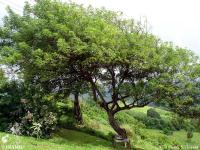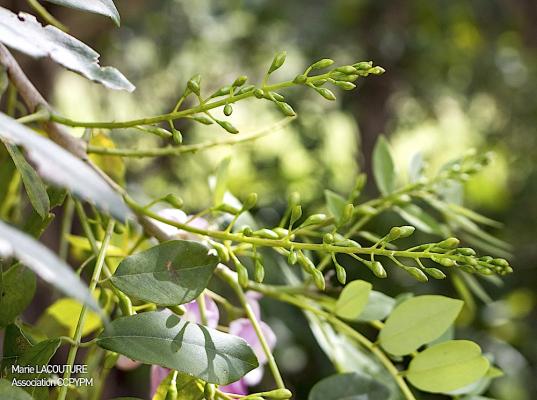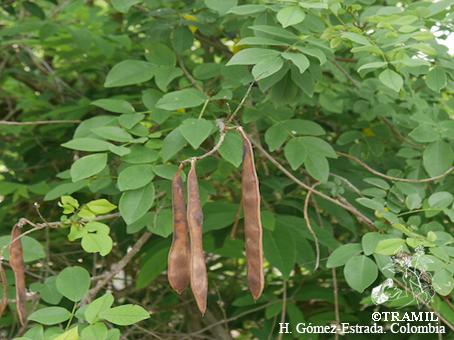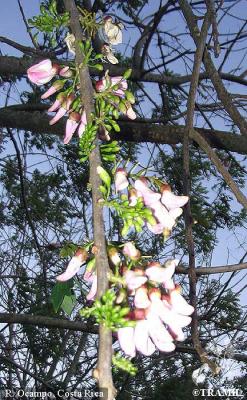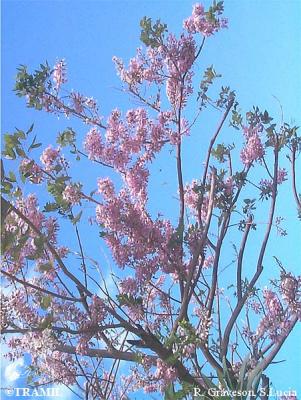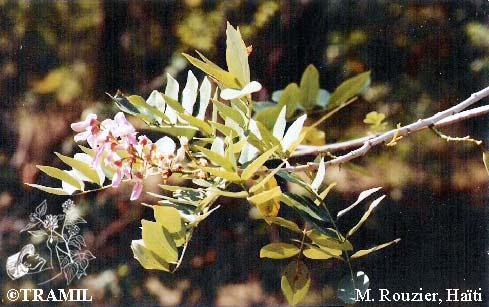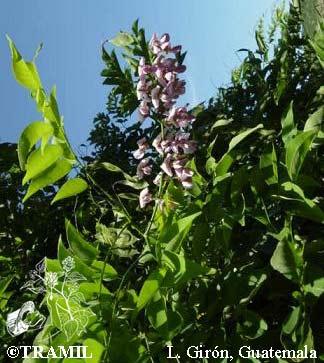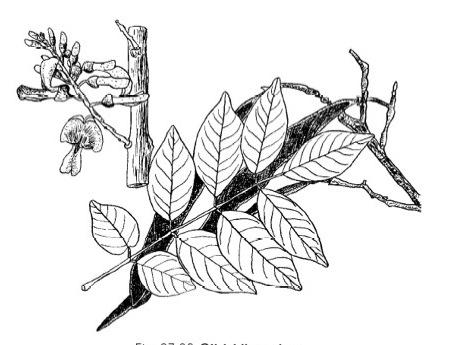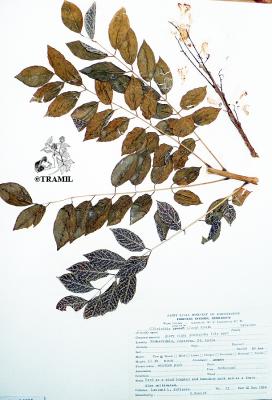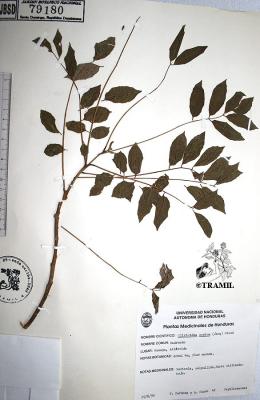Noms vernaculaires
(dans les territoires avec usage significatif TRAMIL)
Martinique:
- glysérya
Honduras:
- madriado
Distribution géographique
Native d'Amérique tropicale, cultivée comme plante à ombrage.
Description botanique
Arbuste ou arbre caducifolié pouvant atteindre 20 m. Feuilles composées imparipennées de 12 à 30 cm de long, avec 7 à 25 folioles, ovées ou elliptiques, glabres sur la face supérieure et finement pubescentes sur la face inférieure, avec présence de taches pourpres mates. Inflorescence racémeuse de 5 à 7 cm, fleurs avec un calice campanulé tronqué, pétales dressés de 2 cm de couleur rose. Fruit, gousse plate linéaire de 10 à 15 cm, graines lenticulaires de couleur brun-jaunâtre à brun.
Voucher(s)
Ochoa, 283, HPMHV
Suazo & Cardona, 42, HPMHV
Longuefosse & Nossin, 148, HAVPM
Pharmacopée
Ed.3References
1 LAGOS-WITTE S, Tinoco R, Merlo V, 1996
Encuesta complementaria TRAMIL. Laboratorio de Histología Vegetal y Etnobotánica, Dep. de Biología, Universidad Nacional Autónoma de Honduras UNAH, Tegucigalpa, Honduras.
2 LONGUEFOSSE JL, NOSSIN E, 1990-95
Enquête TRAMIL. Association pour la valorisation des plantes médicinales de la Caraïbe AVPMC, Fort de France, Martinique.
3 COMISION NACIONAL PARA EL CONOCIMIENTO Y USO DE LA BIODIVERSIDAD, 2010
Gliricidia sepium: www.conabio.gob.mx/conocimiento/info_especies/arboles/doctos/29-legum19… (18/11/2011)
4 CALLE J, RIVERA A, JOSEPH-NATHAN P, 1987
Pinitol from the leaves of Gliricidia sepium. Planta Med 53(3):303.
5 DAYAL R, 1985
Phytochemical investigation on flowers of Gliricidia sepium. J Indian Chem Soc 62(2):171.
6 RASTRELLI L, CACERES A, DE SIMONE F, AQUINO R, 1999
Studies on the constituents of Gliricidia sepium (Leguminosae) leaves and roots: Isolation and structure elucidation of new triterpenoid saponins and aromatic compounds. J Agric Food Chem 47(4):1537-1540.
7 WINA E, MUETZEL S, BECKER K, 2005
The Impact of saponins or saponin-containing plant materials on ruminant productions: A Review. J Agric Food Chem 53(21):8093-8105.
8 ROJAS JJ, OCHOA VJ, OCAMPO SA, MUÑOZ JF, 2006
Screening for antimicrobial activity of ten medicinal plants used in Colombian folkloric medicine: A possible alternative in the treatment of non-nosocomial infections. BMC Complementary and Alternative Medicine 6(1):2.
9 CACERES A, LOPEZ BR, GIRON MA, LOGEMANN H, 1991
Plants used in Guatemala for the treatment of dermatophytic infections. I. Screening for antimicotic activity of 44 plant extracts. J Ethnopharmacol 31(3):263-276.
10 ZULUAGA A, UPEGUI I, RODRIGUEZ CJ, OCAMPO MC, RESTREPO M, PARRA GJ, TORRES Y, 2005
Ensayo clínico fase I para evaluar la terapia con Gliricidia sepium en lesiones cutáneas de primates de la familia Cebidae. Rev CES Med 19(1):9-19.
11 CACERES A, LOPEZ B, GONZALEZ S, BERGER I, TADA I, MAKI J, 1998
Plants used in Guatemala for the treatment of protozoal infections. I. Screening of activity to bacteria, fungi and American trypanosomes of 13 native plants. J of Ethnopharmacology 62(3):195-202.
12 CACERES A, LOPEZ B, GONZALEZ S, BERGER I, TADA I, MAKI J, 1998
Plants used in Guatemala for the treatment of protozoal infections: I. Screening of activity to bacteria, fungi and American trypanosomes of 13 native plants. J Ethnopharmacol 62(3):195-202.
13 DHAWAN BN, PATNAIK GK, RASTOGI RP, SINGH KK, TANDON JS, 1977
Screening of Indian plants for biological activity. VI. Indian J Exp Biol 15(3):208-219.


